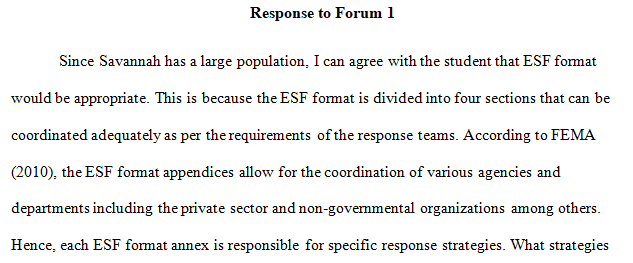
Developing and Maintaining Emergency Operations Plans Comprehensive Preparedness Guide (CPG) 101 Version 2.0. (2010).
Response to Forum 1
In need of a 125 response/discussion to EACH of the following forum posts. There are (2) different Forum posts. Agreement/disagreement/and/or continuing the discussion. The two interactive posts should each be substantial, relevant, and engaging. Replies to classmates should include direct questions. In-text citations and references may be in APA format. Original forums discussion/topic post is as follows: (Use/Cite references to support your ideas)
I have attached the Comprehensive Preparedness Guide (CPG 101). Chapters 2 & 3 were used for this discussion.
Responses to Discussion Posts of Other Participants
Student replied to two other students’ initial posts and included at least two of the following areas:
- Validates post with additional evidence from the literature and attribution is given to the author or creator of the work.
2. Poses a thoughtful question.
3. Provides an alternative point-of-view.
4. Offers additional insight into how the concept might be understood.
Student advanced the weekly conversation by replying back to everyone that replied to their initial post.
Responses met the minimum word count and contained no spelling, grammar, or punctuation errors.
Responses were on time.
Forum 1
Hello Class,
After reading Chapter 3 in the Comprehensive Planning Guide, choose the EOP format that would be best suited to use in the creation of a plan for your area. Be sure to use evidence from the reading and your area to support your posting. Please start a new thread when creating your initial post and write any responses to others within their existing discussion threads. To receive full credit, be sure to respond to at least two of your classmates’ postings.
Having different format options is a nice guide for a diverse set of communities. I live in Savannah, Georgia. I believe this jurisdiction would create a plan best by using the ESF Format. According to the Comprehensive Preparedness Guide (CPG) 101, “in a sprawling metropolitan county that contains several municipalities and has a complex government structure, county emergency operations may assume more of a coordination and support role” (3-3). Savannah is quite large with a population of approximately 680,000. Savanah has a large area to cover when responding to incidents. There are more supporting hospitals and there are higher threat levels for terrorist with locations like the International airport adjacent to an Air National Guard Base. This city is only growing, and it now has a new technological hazard. Savannah’s International Sea Port incorporated a liquified natural gas tank located on the Savannah River and begins operations this year.
The Emergency Support Function Format has Four main sections:
- Basic Plan,
- Emergency Support Function Annexes
- Support Annexes
- Hazard, Threat, or Incident-Specific Annexes
ESF Coordinators would be selected and assist in the Emergency Operations Plan. ESF Coordinators would also be in charge of preparedness, drills, and exercises in their respected function fields. Support Annexes will have an all-hazards approach. In the next section, it further breaks down into Incident-Specific Annexes. Each hazard, threat, or incident-specific annex should have considerations to policies, situation, CONOPS, and responsibilities (3-7). I like the way this format is laid out; it is very easy to follow and locate needed information.
Fast Facts. (n.d.). Retrieved August 15, 2020 from https://www.visitjacksonville.com/media/fast-facts/
FEMA. (2010, November). Comprehensive Preparedness Guide (CPG) 101. Retrieved August 15, 2020 from https://www.fema.gov/media-library-data/20130726-1828-25045-0014/cpg_101_comprehensive_preparedness_guide_developing_and_maintaining_emergency_operations_plans_2010.pdf
Forum 2
Good evening class,
After reading Chapter 3 in the Comprehensive Planning Guide, choose the EOP format that would be best suited to use in the creation of a plan for your area.
Proper structuring of an Emergency Operation Plan is essential in planning for potential emergencies. “All EOP styles should flow from a basic plan 913 that outlines the jurisdiction’s overall emergency organization and its policies.” (FEMA, 2010) The Comprehensive Planning Guide outlines three types of formats that can be used in the preparation of an EOP. The Traditional Functional Format which is used by many jurisdictions. Next, the Emergency Support Function Format, which is used primarily at the state level, and lastly, the Agency-/Department Focused Format, which addresses each department’s or agency’s tasks in a separate 1003 section.
While planning on what EOP format would be best for my area, I considered which format would be the most effective and applicable. This led to me choosing the Agency-/Department-Focused Format. This format includes lead and support agency sections and hazard-specific procedures for the individual agencies. “This format allows EOP users to review only those procedures specific to their agency without having to 1020 review other agencies’ response tasks.” (FEMA, 2010) I live in a moderately large community with bustling activity. This plan allows for added flexibility and voluntary options for collaboration among the different agencies in the event of a disaster.
References
Developing and Maintaining Emergency Operations Plans Comprehensive Preparedness Guide (CPG) 101 Version 2.0. (2010). Retrieved 2020.
Answer preview…………………………….
 apa 296 words
apa 296 words